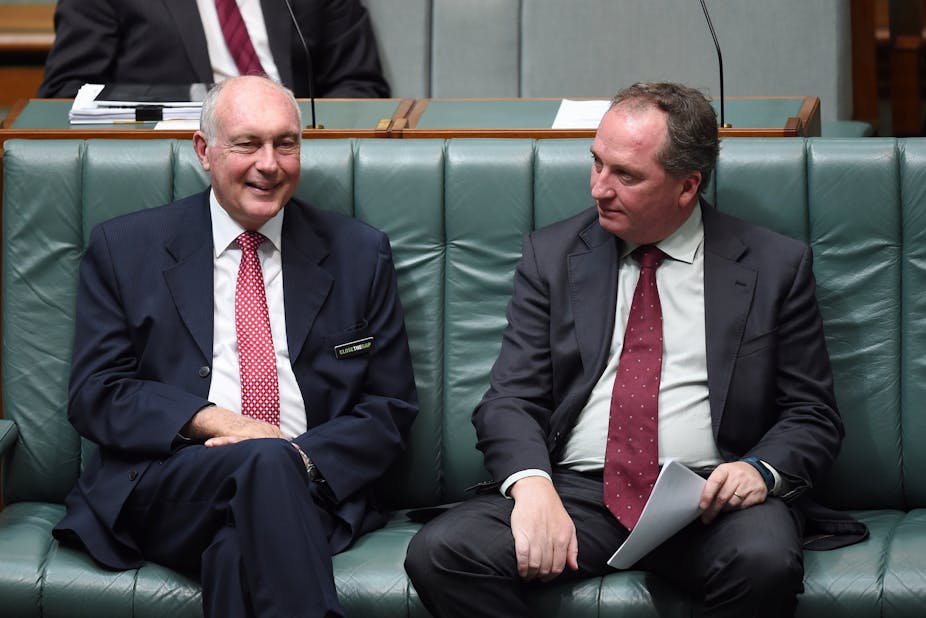A new dynamic is coming to the Turnbull government with Deputy Prime Minister Warren Truss finally set to announce on Thursday that he will quit the Nationals leadership, ahead of retiring at the election.
Trade Minister Andrew Robb last night confirmed he would also leave at the election. Robb says he will stay in his job for “some months, perhaps” to complete his work, with Malcolm Turnbull to announce “when I’ll step down and who will replace me”. But Robb’s departure doesn’t have any of the ramifications of the Nationals’ change.
Truss’s exit from the leadership, which he plans to be on March 17, clears the way for Turnbull to reshuffle his ministry and Barnaby Joyce to take over as deputy prime minister.
But the timetable raises problems. Unless Truss’s successor is nominated quickly – and the word on Wednesday was that there would not be a vote this week – there will be a hiatus and internal unrest in the Nationals, which could potentially weaken their position in the run-up to the reshuffle.
It is understood that Turnbull discouraged Truss from announcing his resignation on a couple of occasions this year. This is contrary to the earlier impression that Turnbull was impatient for Truss to clarify his future. Turnbull’s motives are unclear, apart from suddenly finding himself with quite a few moving parts.
The ascension of Joyce – who is confident of having the numbers for the position – will have consequences, as yet difficult to predict, for the senior reaches of the government.
Joyce is less economically dry and more politically assertive than Truss. He has calmed down from his early days as a roguish senator from Queensland, but he has a lot to prove. Over time he will be trying to aggressively “grow” the Nationals. Retail politics is his forte and he will be a lot more visible than Truss.
The first test will be when Coalition arrangements for the new team are finalised, with the Nationals pressing their entitlement to an extra cabinet place.
Joyce will have to decide whether to stay in his present agriculture portfolio, or move to Truss’s infrastructure one. The Nationals, who hanker for an economic ministry, would love to get the trade portfolio back. It used to be theirs and is soon to be vacant, but the Liberals would not cede it. Joyce could only lay claim to it if it were for himself, but that’s impossible because it would take him out of the country too much.
Just as we will not see the “real Malcolm” until after he wins an election, so the “real Barnaby” might be veiled until then.
In the short term, Joyce will have his work cut out learning to lead and managing the team, which includes some critics. He is not personally close to Turnbull – as he was to Tony Abbott – but it is in their mutual interests to reach accommodations as the election approaches.
But post-election, assuming a win, Joyce will pick his issues and pursue them, seeking to sharpen the Nationals’ identity.
The decision of Robb, 64, to retire was unexpected but not altogether surprising, given earlier speculation that he might not recontest.
Robb has been one of the most successful ministers, achieving trade agreements with Japan, Korea and China as well as conducting successful negotiations for Australia’s participation in the Trans-Pacific Partnership. He has performed much better in government than in opposition.
Robb said he felt “the time is right” for his next career, which would be in the private sector. “It is an opportune time to hand over the baton to the talented next generation in our party.”
The Turnbull reshuffle will be substantial. Apart from appointing a trade minister, albeit with a pause, he has to fill the vacancy left by the resignation of Jamie Briggs, and to decide whether to tell Mal Brough – who has stood aside pending the completion of a police investigation – that his spot can’t be held open indefinitely.
Great doubt also hangs over Human Services Minister Stuart Robert, after revelations about his 2014 private visit to China, when he attended a signing ceremony involving the company of his friend and Liberal donor Paul Marks, and also had talks with a Chinese vice minister, with Marks’ company part of the occasion.
It has looked very bad for the embattled minister. But senior sources were hedging their bets on Wednesday, with uncertainty over how much Robert, assistant defence minister at the time, had told the Abbott prime ministerial office beforehand about the circumstances of the trip.
If the Abbott office, which approved his leave for the visit, knew the details, it would strengthen Robert’s position.
A Senate estimates committee heard on Wednesday that Robert’s chief-of-staff had written to Abbott’s chief-of-staff, Peta Credlin, seeking approval for him to travel from Beijing to Singapore, where he had official duties. Later his office advised the Defence Department of people he had met in China.
Turnbull has the secretary of his department, Martin Parkinson, advising whether Robert has breached the ministerial code of conduct.
As Parkinson probes, more information is coming out. The Herald Sun reports that in 2013 Robert organised a dinner in his Parliament House office, at the request of Marks, for a Chinese businessman. The function, held not long before the election, was attended by Abbott, Credlin and other Liberals – including Scott Morrison. The businessman handed out designer watches, which guests returned after they discovered they were not fake (or tried to return – the businessman had by then disappeared and the watches went to Marks).
Whatever happened with the Abbott office before the Beijing trip presents a complication in judging the Robert case. But with more bad stories always a risk, Robert should be cut loose, and soon. Turnbull would not want to have to revisit the Robert issue after his reshuffle.

